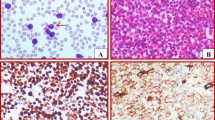Abstract
Genetic diagnosis is currently considered the most reliable method to accurately identify patients with acute promyelocytic leukemia (APL) requiring tailored therapy including all-trans retinoic acid (ATRA). We investigated the clinical effectiveness of immunofluorescence techniques with the anti-PML monoclonal antibody PG-M3 for rapid and accurate diagnosis of APL. PML immunofluorescence staining was analyzed in 164 patients with acute myeloblastic leukemia (AML), including APL (110 patients) and non-APL subtypes (54 patients). All 54 patients with an AML phenotype, in whom tests for t(15;17) or its fusion gene PML/RARα were negative, showed a speckled (macrogranular) nuclear pattern. Of the 110 genetically diagnosed APL patients, 108 showed a microgranular pattern that confirmed PG-M3 positivity. The remaining two patients were not evaluable for PG-M3 reactivity because of scarcity of cells. No patient with APL showed a normal pattern. The high sensitivity and specificity of immunolabeling using PG-M3 monoclonal antibody show that it is a highly efficient and reliable tool to identify PML/RARα-positive patients with APL and that it should be standardized as a first-line diagnostic procedure. In addition, it is technically simple, fast, and cheap, only requiring small tissue samples and non-sophisticated equipment.

Similar content being viewed by others
References
Lo Coco F, Diverio D, Falini B, Biondi A, Nervi C, Pelicci PG (1999) Genetic diagnosis and molecular monitoring in the management of acute promyelocytic leukemia. Blood 94:12–22
Daniel MT, Koken M, Romagne O, Barbey S, Bazarbachi A, Stadler M et al (1993) PML protein expression in hematopoietic and acute promyelocytic leukemia cells. Blood 82:1858–1867
Dyck JA, Warrell RPJ, Evans RM, Miller WH Jr (1995) Rapid diagnosis of acute promyelocytic leukemia by immunohistochemical localization of PML/RAR-alpha protein. Blood 86:862–867
O’Connor SJ, Forsyth PD, Dalal S, Evans PA, Short MA, Shiach C et al (1997) The rapid diagnosis of acute promyelocytic leukemia using PML (5E10) monoclonal antibody. Br J Haematol 99:597–604
Flenghi L, Fagioli M, Tomassoni L, Pileri S, Gambacorta M, Pacini R et al (1995) Characterization of a monoclonal antibody (PG-M3) directed against the amino-terminal portion of PML gene product: immunocytochemical evidence for high expression of PML proteins on activated macrophages, endothelial cells, and epithelia. Blood 85:1871–1880
Falini B, Flenghi L, Fagioli M, Lo Coco F, Cordone I, Diverio D, et al. (1997) Immunocytochemical diagnosis of acute promyelocytic leukemia (M3) with the monoclonal antibody PG-M3 (Anti-PML). Blood 90:4046–4053
Villamor N, Costa D, Aymerich M, Esteve J, Carrio A, Rozman M, et al. (2000) Rapid diagnosis of acute promyelocytic leukemia by analyzing the immunocytochemical pattern of the PML protein with the monoclonal antibody PG-M3. Am J Clin Pathol 114:786–792
Samoszuk MK, Tynan W, Sallash G, Nasr S, Monczak Y, Miller W (1998) An immunofluorescent assay for acute promyelocytic leukemia. Am J Clin Pathol 109:205–210
Bennett JM, Catovsky D, Daniel MT, Flandrin G, Galton DA, Gralnick HR, Sultan C (1985) Proposed revised criteria for the classification of acute myeloid leukemia. A report of the French–American–British Cooperative Group. Ann Intern Med 103:620–625
Hernández JM, Martín G, Gutiérrez NC, Cervera J, Ferro MT, Calasanz MJ, et al. (2001) Additional cytogenetic changes do not influence the outcome of patients with newly diagnosed acute promyelocytic leukemia treated with an ATRA plus anthracyclin based protocol. A report of the Spanish group PETHEMA. Haematologica 86:807–813
ISCN (1995) Guidelines for cancer cytogenetics. In: Mitelman F (ed) Supplement to: an international system for human cytogenetic nomenclature. Karger, Basel
Bolufer P, Barragán E, Sanz MA, Martín G, Bornstein R, Colomer D, et al. (1998) Preliminary experience in external quality control of RT-PCR PML/RARα detection in promyelocytic leukemia. Leukemia 12:2024–2028
Acknowledgments
The authors thank all the Spanish institutions that contributed to this study by sending diagnostic samples.
Author information
Authors and Affiliations
Corresponding author
Rights and permissions
About this article
Cite this article
Gomis, F., Sanz, J., Sempere, A. et al. Immunofluorescent analysis with the anti-PML monoclonal antibody PG-M3 for rapid and accurate genetic diagnosis of acute promyelocytic leukemia. Ann Hematol 83, 687–690 (2004). https://doi.org/10.1007/s00277-004-0902-7
Received:
Accepted:
Published:
Issue Date:
DOI: https://doi.org/10.1007/s00277-004-0902-7




